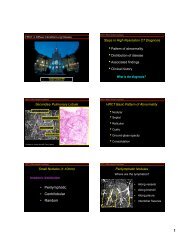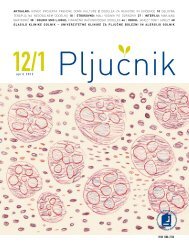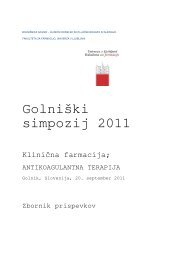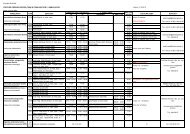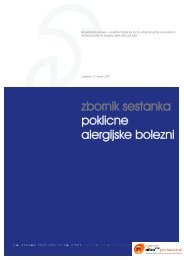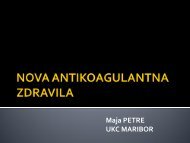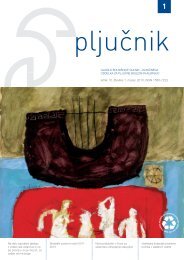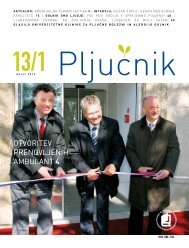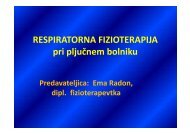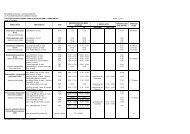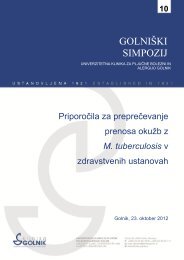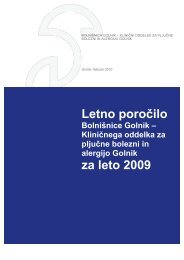Golniški simpozij 2011 Zbornik povzetkov
Golniški simpozij 2011 Zbornik povzetkov
Golniški simpozij 2011 Zbornik povzetkov
You also want an ePaper? Increase the reach of your titles
YUMPU automatically turns print PDFs into web optimized ePapers that Google loves.
creased ECM deposition that is characteristic for this disease. The number of smooth muscle actinpositive,<br />
activated (myo-) fibroblasts is significantly increased in multiple forms of pulmonary fibrosis<br />
including IPF, but their origin remains to be elucidated.<br />
Currently, three major theories attempt to explain this hallmark of maladaptive cell activation:<br />
1. It has been demonstrated that resident pulmonary fibroblasts proliferate in response to fibrogenic<br />
cytokines and growth factors (see below), thereby increasing the local fibroblast pool via local fibroproliferation.<br />
2. In addition, several recent studies have shown that bone marrow-derived circulating fibrocytes<br />
traffic to the lung during experimental lung fibrosis, and serve as progenitors for interstitial fibroblasts.<br />
In particular, collagen I-positive fibrocytes have been shown to traffic to injured lungs in a<br />
chemokine-dependent fashion, integrate into the lung ECM, and contribute to enhanced collagen<br />
synthesis in fibrosis.<br />
3. It was recently proposed that PII cells are capable of undergoing the process of epithelial-to-mesenchymal<br />
transition (EMT), the phenotypic, reversible switching of epithelial to fibroblast-like cells,<br />
which is initiated by an alteration of the transcriptional and proteomic profile of P2 cells. The orchestrated<br />
series of events initiating EMT include remodelling of epithelial cell-cell and cell-matrix<br />
adhesion contacts, reorganization of the actin cytoskeleton, and induction of mesenchymal gene<br />
expression.<br />
EMT is a highly controlled process initially discovered and described in embryonic development and<br />
morphogenesis. In addition, EMT has gained wide recognition as a mechanism that facilitates cancer<br />
progression and metastasis, as well as the development of chronic degenerative fibrotic disorders<br />
of the kidney, liver, and lung. Transforming growth factor (TGF)-b is a main inducer and regulator<br />
of EMT in multiple organ systems.<br />
What are the major signalling pathways for matrix remodelling in the lung?<br />
As a kind of primary wound healing response, activation of the coagulation cascade and suppression<br />
of the fibrinolysis system has been observed in patients with IPF, and the cellular origin of these<br />
coagulation factors (alveolar macrophages and P II cells) has been disclosed. Analysis of bronchoalveolar<br />
lavage fluids (BALF) revealed substantial activation of the extrinsic coagulation pathway<br />
(tissue factor VII), alongside with pronounced suppression of antithrombotic (activated protein C) or<br />
fibrinolytic (plasminogen activator inhibitor 1) activities. These changes promote alveolar and interstitial<br />
fibrin deposition, forming a provisional matrix and thereby contributing to lung fibrosis. Moreover,<br />
several procoagulant serine proteases such as TF/FVII, factor X and thrombin induce fibrotic<br />
events via the Protease activated receptors PAR-1 and PAR-2. In response to the activation of this<br />
G-protein coupled receptor, increased ECM production, secretion and induction of profibrotic growth<br />
factors such as TGF-b and PDGF can be observed. Vice versa, the urokinase system has repeatedly<br />
been shown to exert strong antifibrotic activity, most likely due to the activation of HGF and the removal<br />
of fibrin and ECM.<br />
With respect to scar formation as aberrant alveolar/interstitial wound healing response, there is currently<br />
no doubt that the Transforming Growth Factor (TGF)-b family represents the pivotal mediator<br />
system. In vitro, TGF-b induces fibroblast chemotaxis, proliferation and transdifferentiation into myofibroblasts,<br />
and it largely promotes the production and secretion of extracellular matrix compounds,<br />
mainly collagen. Application of TGF-b encoding adenoviral vectors to the distal lung induces a progressive<br />
and severe lung fibrosis. Likewise, application of these vectors to the pleural space induces<br />
pleural fibrosis and subpleural lung fibrosis as seen in IPF. Increased TGF-b signalling is also observed<br />
in other animal models of lung fibrosis, such as the bleomycin model, where collagen deposition<br />
is reduced by TGF-b antibodies and soluble TGF-b receptors. In lungs of IPF patients, increased<br />
expression of TGF-b has been observed in close proximity to areas of increased ECM deposition.<br />
Apart from TGF-b, there are also other growth factors such as PDGF (platelet-derived growth factor),<br />
CTGF (connective tissue growth factor), members of the Wnt pathway, or IGF-I (insulin-like growth<br />
factor I) and endothelin, which may significantly<br />
contribute to the pathogenetic sequelae of IPF.<br />
16



